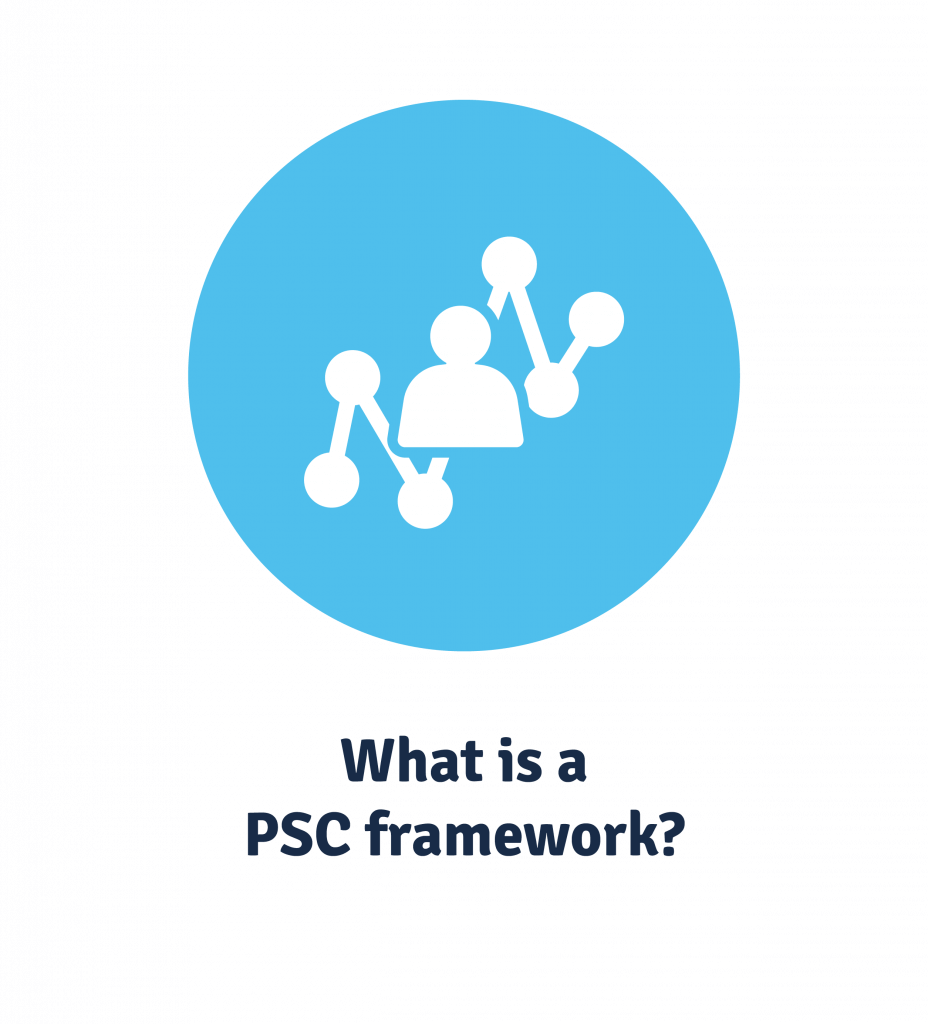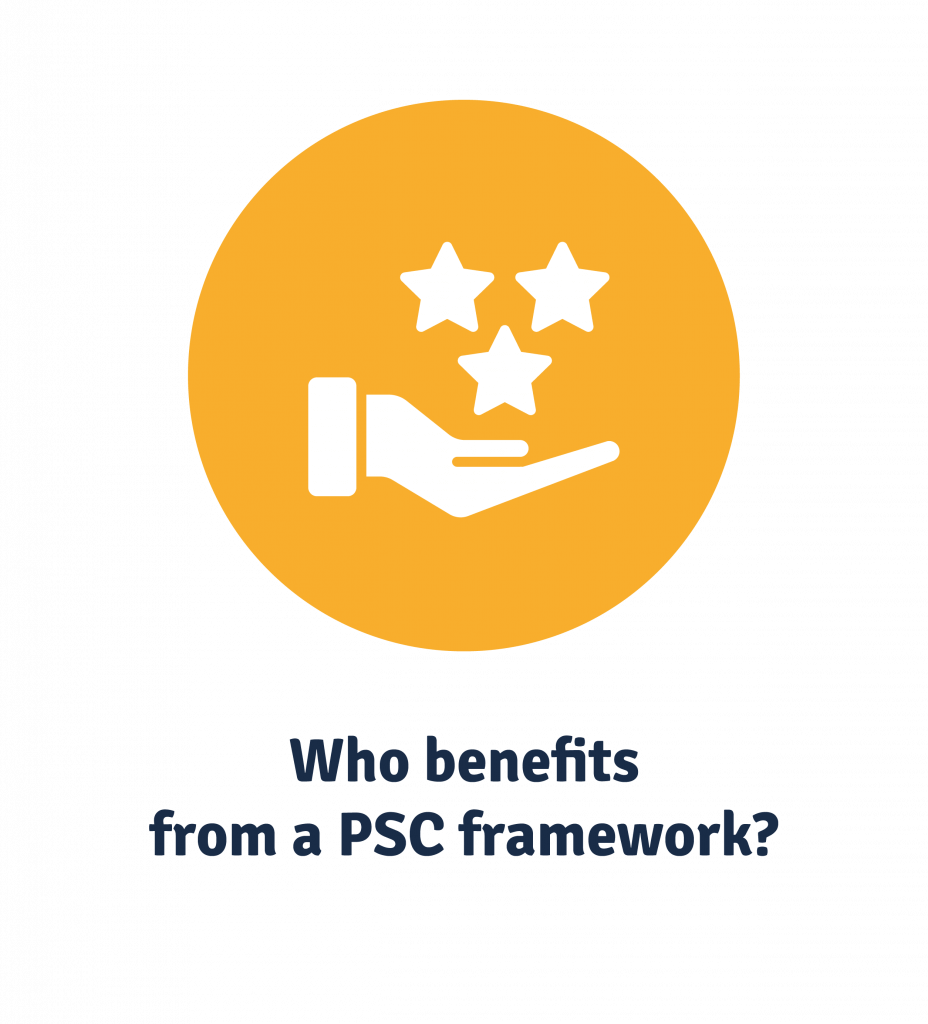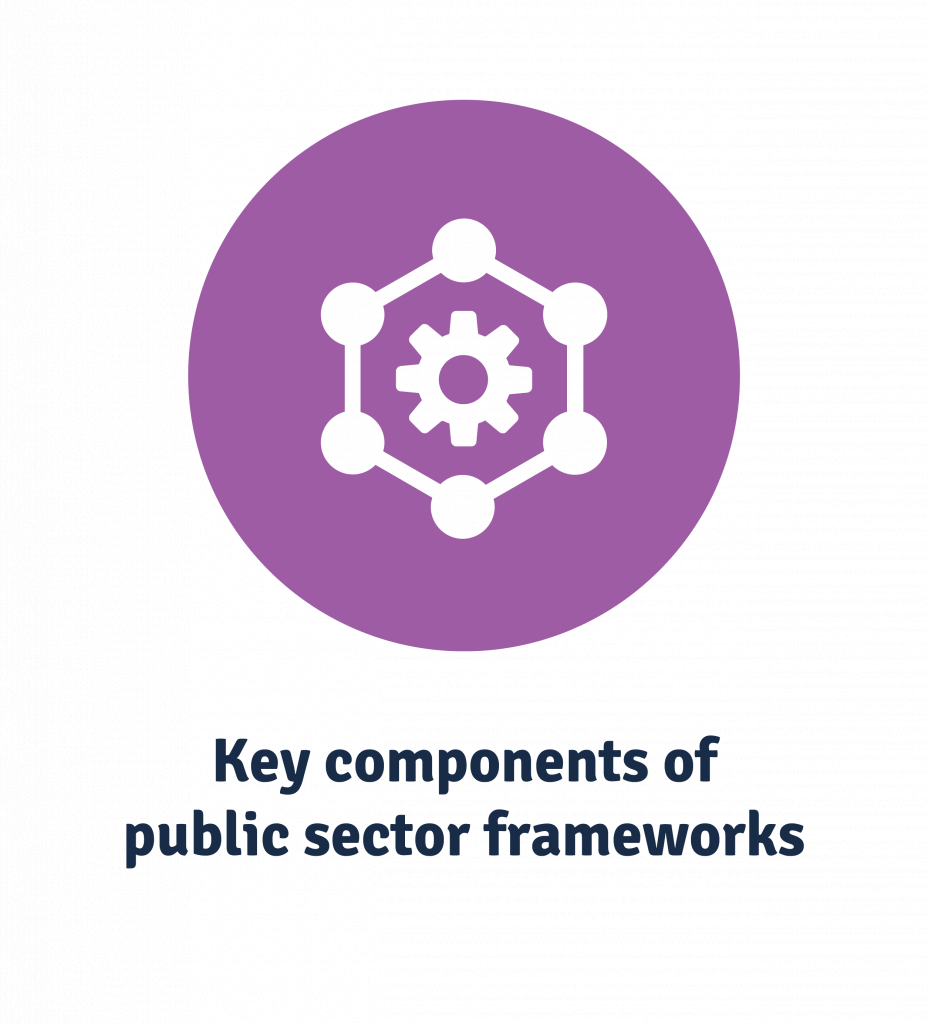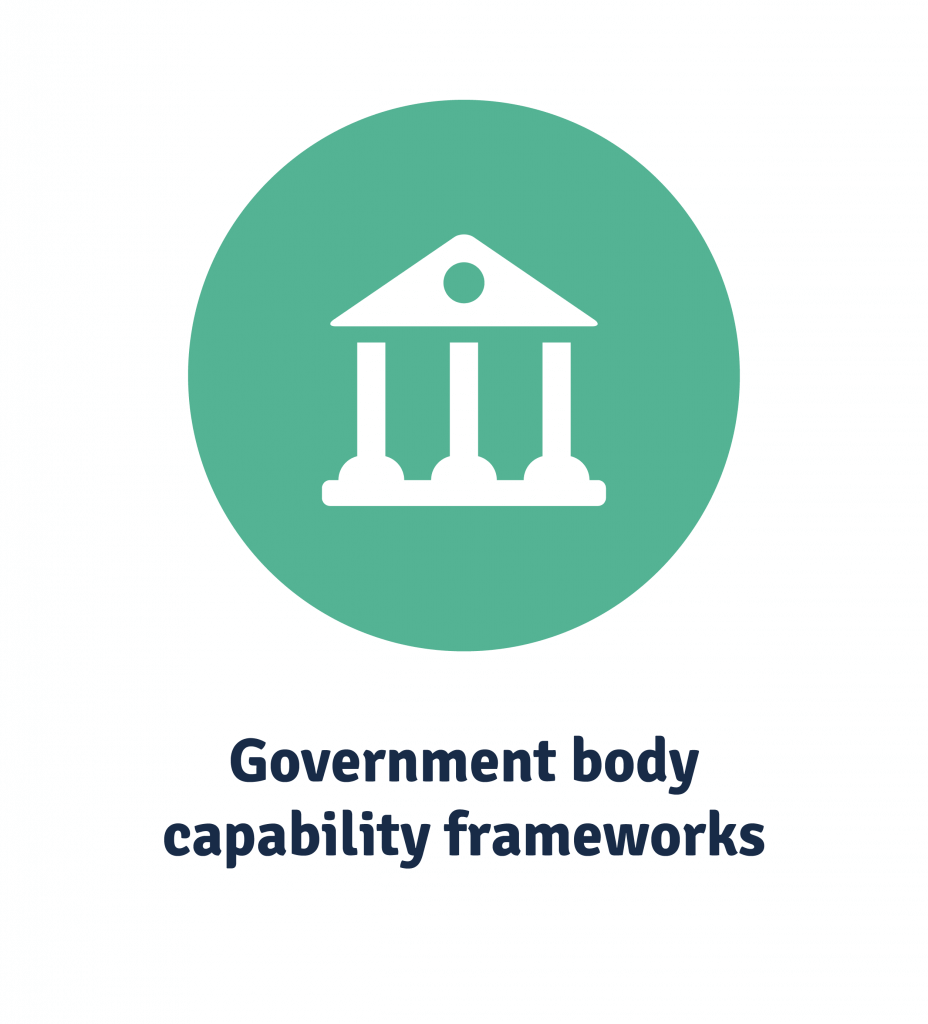A Deep Dive into Public Sector Capability Frameworks & What Private Enterprise Can Learn from Them
We recently took a dip into the shallow end of this pool, where we learned why public entities put their own spin on capability frameworks.
Public sector capability frameworks serve a different master to private enterprise models. That is, the actions of the public service workforce directly impacts community, and so their objectives are to establish success-driven behaviours.
This guide will take a deeper dive into the benefits of public sector capability frameworks, some different examples from around the world, and what private business can learn from how they are used.
What is a PSC framework?
A public sector capability (PSC) framework is a tool that supports a public service or enterprise in attracting, recruiting, developing and retaining a high-performing workforce. It defines the behaviours that indicate a level of skill, knowledge and aptitude attributed to a specific job role or level.
Who benefits from a PSC framework?
The results are similar between private and public organisations. Organising expectations and requirements enables organisations to align their goals with the minutiae of culture that achieve success.
So, in short, everyone wins. The long version? It has some specific advantages for different job roles.
For individual contributors: Aligned performance and organisational outcomes
Individual contributors (ICs) are those without managerial responsibility, aka those responsible for themselves and accountable to other people. For public sector ICs, a PSC framework is the missing link between:
- Day-to-day and high performance
- Their role’s purpose and organisation objectives.
The Australian Central Territory Public Service (ACTPS) defines a capability as a signal that one can be relied on to repeatedly deliver that skill, knowledge or behaviour. We also know that capabilities are cumulative, meaning that they illuminate a pathway for performance progression. A framework therefore outlines the repeated behaviours and actions that are valued in an organisation, and therefore more likely to be recognised and rewarded.
Essentially, it shows employees how they need to consistently perform in their role (not just in the lead up to their annual review, for example) to achieve their career goals in line with their organisation’s outcomes. It gives them the tool for self-awareness in their role. This establishes an environment in which everyone’s working to the same standard.
For HR: Recruitment and retention standards
There are a few distinctions for HR roles in the public sector as opposed to private. Sector-specific conditions can vary more than industry-specific, and research generally agrees that the public sector workforce largely has different motivations to private sector workers. This makes human resource management a different ballgame when it comes to recruiting and retaining talent.
The common driver for HR in the public service remains understanding the needs of an organisation, specifically what people and expertise they need to achieve their goals—often within much stricter boundaries than in the private sector.
A PSC framework provides the “how” of a role, giving HR the tool to identify accountabilities for every position. Given there can be dozens of roles that need servicing at any one time across multiple levels of responsibility, this powers smarter recruitment, job descriptions, team creation, and performance and development—in the name of culture as much as success.
For executives: More clarity
In unstable environments, adaptive, resilient leaders enable their agencies to work with speed and impact. Yet less focus on the bottom line, often less clarity of who’s “running this place” and tangible economic impacts put a different kind of pressure on senior public executives. This is even more true of those overseeing large-scale project delivery, public policy and ensuring the integrity of high-level decision-making.
Many senior executives are held to high moral standards in the public sector; the Organisation for Economic Co-operation and Development (OECD) promotes merit, transparency, accountability and following the letter of the law as leadership capabilities for government workers. The added benefit is that not only do capability frameworks drive their own performance, but executives get a better look at how the workforce is managed and structured which can inform future projects and resourcing.
How do public entities develop capability frameworks?
Public services exist in many iterations around the world. There are a few shared elements you’ll find in their frameworks, though.
- The, well, public nature of their frameworks. Very often, this serves the purpose of giving job seekers insight into the expertise and behaviours expected in the public service. This is in line with the predetermined career pathways afforded in public enterprises (compared to often un-traditional trajectories in private).
- It’s common for these frameworks to have shallow granularity but more detail at the levels they do explore.
- Behavioural indicators, or clear expressions of a desired behaviour, are often what give that detail.
Let’s look at some of the different formats, purposes and applications for PSC frameworks.
Public service commission capability frameworks
Acting as a central agency for public sector regulation, public service commissions can be found at state or federal levels depending on the country. Their role is to produce legislation, so you can bet their capability frameworks act as ironclad backbones for the body.
NSW Public Service Commission (Australia)
What it is
NSW Public Sector Capability Framework
Falls under
Workforce management
In their own words
“The NSW Public Sector Capability Framework gives the large and diverse public sector a shared language to describe the capabilities needed to perform work at different levels across different occupation groups.”
How they use it
A common trait amongst most leading PSC frameworks is fewer levels of granularity compared to private org examples. Many focus on less than ten core capabilities, reserving detail for the behaviours expected across multiple levels of proficiency.
Where they begin to distinguish themselves is on how they determine proficiency, either by job level or job role. This gives a different insight into career pathways as much as personal performance. And in fact, the NSW framework outwardly does neither; their proficiency levels are expected to be eventually attained by all employees.
Bar an additional grouping (of People Management for, you guessed it, people managers), the NSW Public Sector Capability Framework arranges four core groups into five levels of proficiency. That’s foundational, intermediate, adept, advance and highly advanced exemplifications of Personal Attributes, Relationships, Results and Business Enablers.
Each capability is denoted by behavioural indicators that are designed to illustrate the degree of knowledge, skill and ability required at every level of proficiency. That brings them to a total of 16.
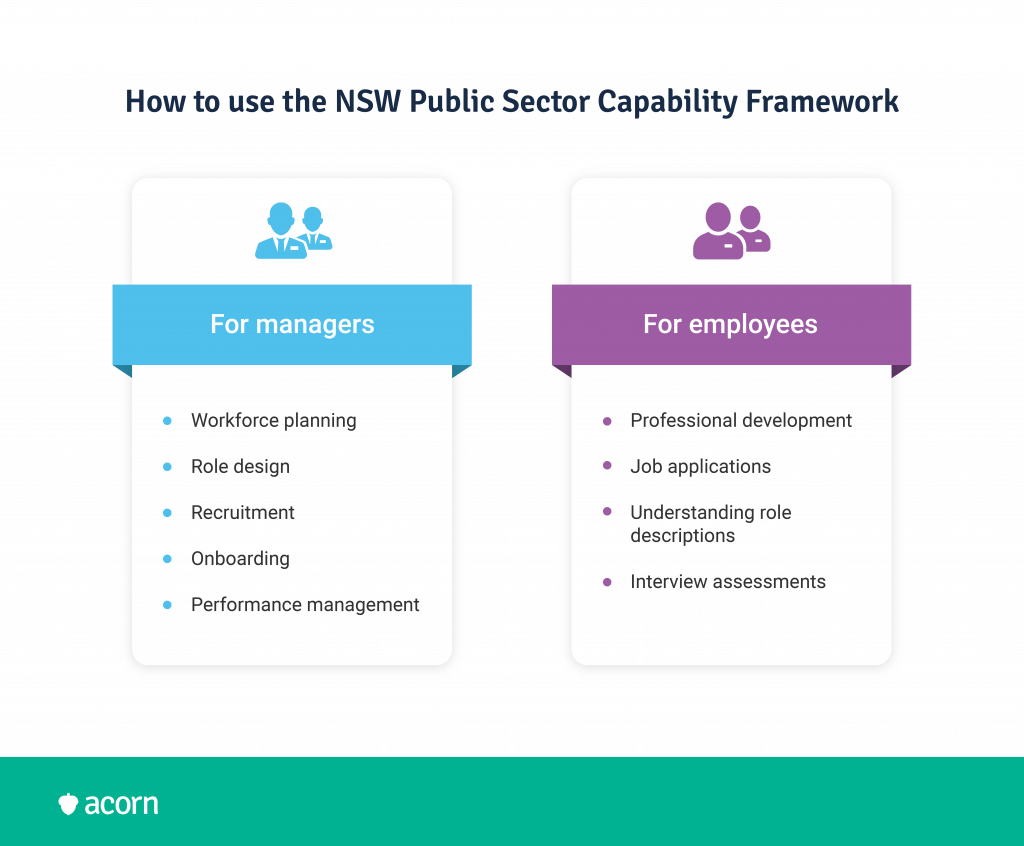
If you’re used to upwards of 30 capabilities in a framework, you’d be excused for wondering how 16 can support the same goals. Well, the framework is just one resource the Commission maintains for NSW Government staff. There’s also:
- The NSW Performance Development Framework to support a high-performance culture.
- The Strategic Workforce Planning Framework to help individual agencies better understand and prepare for their future workforce needs.
- The Leadership Framework that underpins the NSW Leadership Academy that develops leaders specifically for the needs of NSW.
All of these are informed by their yearly State of the NSW Public Sector Report, which defines clear KPIs for the sector as whole. (Remember, their core set describes behaviours expected of all individuals, not just a role.)
Another differentiating factor for this example is the occupation-specific capability sets for:
- Infrastructure & construction leaders
- Legal
- Procurement
- ICT
- Finance
- Human resources
- Property acquisition.
The thinking here is that many of these fields require complex expertise and behaviours, as well as specific tertiary education and occupational experience. Occupation-specific sets then supplement the framework. For example, a Legal Professional would be expected to have certain expertise specific to their field: Statutory Interpretation, Legal Research, and Legal Advice. These aren’t expected of whole-of-government, but they are certainly skills that underpin effective performance in a legal role. However, legal roles will also need those core picks (such as Communicate Effectively) that are outlined in the core set. You see the alignment.
Lesson learnt
A capability framework underpins your workforce, but it need not be the only resource if you find its succinct nature doesn’t cover all your bases. Occupation, performance and workforce activity-specific frameworks may be worthwhile if you have niche skillsets in your business.
WA Public Sector Commission (Australia)
What it is
Public Sector Capability Profiles
Falls under
Whole of government
In their own words
“Our capability profiles create a framework to identify the critical capabilities at each level across the WA public sector.”
How they use it
Similar to the NSW State of the Workforce Report, the Government of Western Australia’s Public Sector Capability Profile is rooted in research on the WA labour market. Specifically, levels of competition and the challenge of the modern workplace to respond to change.
The Profile is unique in its purpose to be fit first for recruitment (especially outside their sector), with workforce planning and performance management a secondary outcome. Their take is that indicative behaviours make for more accurate job descriptions, more efficient and effective selection processes, and better role appointments.
Five capabilities are described for the skills and behaviours at job levels 1–6. Grading by levels rather than specific roles recognises that there are unique jobs and structures within the WA public service, which means that it can be contextualised by different agencies as needed. They don’t break down their core set further except to describe the behaviours expected of optimal performance.
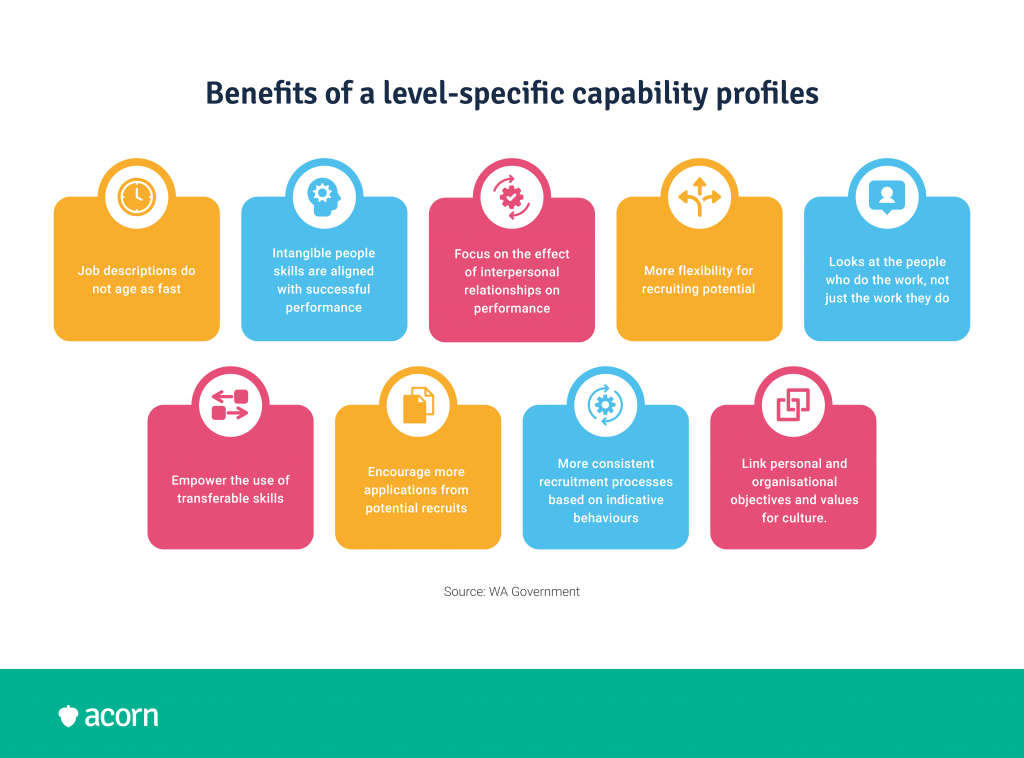
They do, however, utilise a Leadership Capability Profile (LCP) for job levels 7 through to top-rank SES (Senior Executive Service). The core set remains the same as in the Profile, but each is broken into a number of further skills. Each skill also comes with a list of behavioural indicators.
The distinction between the LCP and Profiles is the former focuses on the intersection of individual and strategy and organisation, though both are cumulative models that take a whole-of-government view. While both are intended to underpin culture and development, neither is considered mandatory to implement.
Lesson learnt
Capabilities should be accessible for ICs as much as HR and business leaders. Understanding explicit applications and proficiencies gives staff the tool for owning their professional development and ensuring it aligns with their organisation’s needs (taking some burden off L&D teams).
Queensland Public Service Commission (Australia)
What it is
QPS Capability and Leadership Framework
Falls under
Capability strategies
In their own words
“The CLF is the first of many tools that the Public Service Commission (PSC) will use to… create a public service that encourages staff to contribute their ideas and help to improve the way we do things and the services we provide to the community.”
How they use it
The QPS Capability and Leadership Framework (CLF) is based on five capabilities with several components and behavioural indicators. Like the previous example, their framework is split between job levels 1 to 7 and 8 to 12 plus senior officers with increasingly nuanced and complex expectations.

As well as underpinning performance evaluations and selection for and prioritisation of professional development (from an L&D leader perspective), the CLF is designed to drive continuous improvement.
This can be seen in how the framework is written and displayed. Shaded cells represent a significant progression of skills needed to move between levels while italicised text shows completely new capabilities. This gives ICs a better understanding of the jump in personal accountability needed to move between job levels—a marked difference from other frameworks on this list, let alone private sector models.

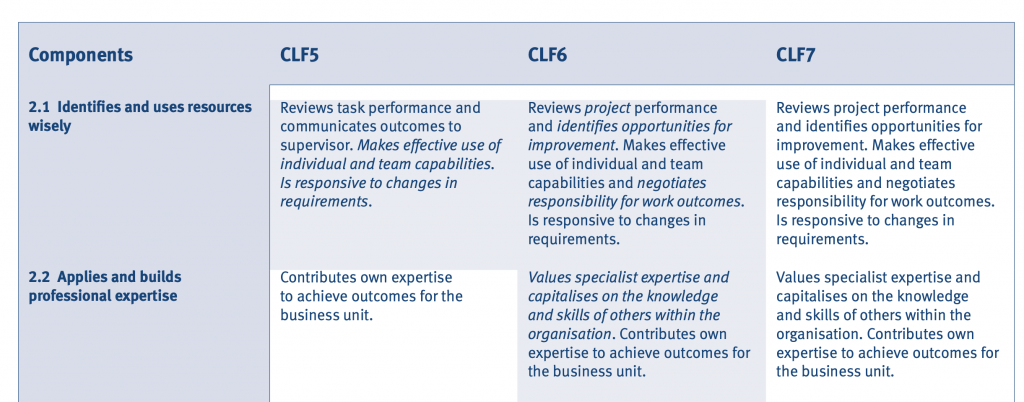
There are two further points of difference for the CLF.
- Rather than being evaluated internally by agencies, the WA Public Service Commission is responsible for managing and reviewing the CLF at a whole-of-government level. Agencies are still expected to adapt the CLF to their context, though.
- The CLF is based on the OG framework, aka the Australian Public Service Integrated Leadership System (ILS), which took a whole-of-government view of capability planning.
However, like other sectors, QPS employs other resources alongside the CLF like Leadership Competencies, Workforce Capability Success Profiles (across four keys roles) and the Strategic Human Resources Competency Framework (for HR professionals).
Lesson learnt
How you display your framework can be as important as how you articulate it. We know heatmapping works for HR’s benefit, but colour cues that indicate progression can also be useful for employees’ self-motivation and L&D.
Civil Service (United Kingdom)
What it is
Success Profiles
Falls under
Government efficiency, transparency and accountability
In their own words
“The Success Profile Framework is being introduced to attract and retain people of talent and experience from a range of sectors and all walks of life, in line with the commitment in the Civil Service Workforce Plan.”
How they use it
The Civil Service, as the UK’s public sector is known, utilises a Success Profile Framework to assess candidates during recruitment as part of their Workforce Plan. Rather than focusing solely on behaviour, the Civil Service bucks the tradition set in this guide to allow candidates to showcase their future potential over past experience.
Based on the now retired Competency Framework, Success Profiles make up the sole recruitment, candidate-facing framework of this guide. The former framework was evolved to facilitate a more flexible process for hiring managers, who found the structure of competency-based interviewing too rigid. For candidates, it opens the door for equal opportunity.
Success Profiles are defined by five elements to assess potential candidates on.
- Experience: Hire based on performance, achievements and skills, including those that are transferable/
- Strengths: Place people in a role they are more likely to enjoy and perform well in.
- Technical: Match the right skills to the right niche or specialisation.
- Ability: Accurately measure one’s potential performance and suitability.
- Behaviours: Understand an individual’s past and potential actions that would result in effective performance.
Behaviours are the only element that utilise competencies from the preceding framework, making them the only element that reflects the frameworks we’ve previously explored. In fact, nine out of ten former competencies are repurposed as effective behaviours with corresponding indicators of proficiencies relating to a job level. It’s not necessary to display all behaviours listed; hiring managers determine what is relevant for a role.
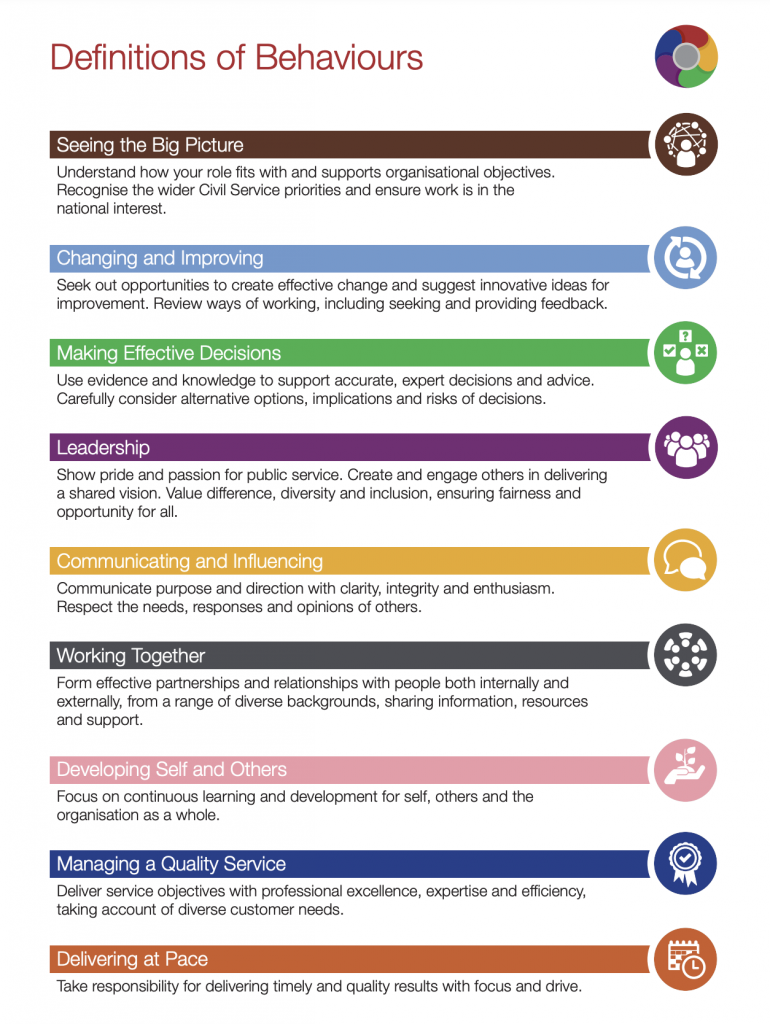
Lesson learnt
Recruitment is an important part of the capability puzzle. Framing them as a blueprint for potential recruits means you can attract the expertise you need, while also giving a snapshot of the culture within your organisation. Hiring based on existing expertise also gives a foundation for L&D and performance management down the line.
Office of Personnel Management (United States)
What it is
MOSAIC competency approach
Falls under
Job assessment & selection
In their own words
The approach uses “a common set of tasks and competencies to structure job design, recruitment, selection, performance management, training, and career development so that employees receive a consistent message about the factors on which they are selected, trained, and evaluated.”
How they use it
The US Office of Personnel Management (OPM) serves as the chief human resources agency for the US Federal Government. Part of their service to other agencies is modelling government-wide competencies, the US equivalent of capabilities. (See: Their definition of a competency as a pattern of knowledge, skills and abilities that ensure successful job performance, aka the “how” of a job.)
The OPM takes a role-based approach to developing competency models. Mission-critical competencies needed in each department are defined to:
- Provide a common language for addressing performance
- Ensure fair and open competition in recruitment
- Align individual behaviour and organisational outcomes
- Aid in succession planning and job redesigns
- Identify individual strengths and weaknesses for development.
Their models are based on the equally job role-focused MOSAIC competencies (Multipurpose Occupational Systems Analysis Inventory – Close-Ended). These create a foundation for almost 200 Federal Government occupations.
However, they stray closer to the business driver basis you’d expect to see in private enterprises. Rather than existing in separate, occupation-specific sets, Economics, Accounting and Horticulture sit beside behavioural Agility, Decisiveness and Creativity as competencies needed across government. This may be because agencies are expected to build their own competency frameworks that inform their unique workforce and performance management needs.
Similar to the Australian examples, the OPM also defines five core Leadership Competencies “needed to build a federal corporate culture that drives results, serves customers, and builds successful teams and coalitions within and outside” any given department. These then have sub- competencies that are defined by behavioural indicators. And like our Australian examples, competencies outlined here are cumulative from Awareness (Level 1) to Expert (Level 5).
Lesson learnt
You may have various functions or arms that have their own unique mission-focused operations. Giving them the power to formulate a foundation that serves their needs could potentially create stronger individual units as much as one great organisation.
Government body capability frameworks
While public service commissions support government, government supports economies, public health and community services. The lessons we can learn here are how capability frameworks can truly benefit individuals.
Local Government NSW (Australia)
What it is
NSW Local Government Capability Framework
Falls under
Public advocacy
In their own words
“The Local Government Capability Framework describes the core knowledge, skills, abilities and other attributes expected of elected members and local government employees in NSW.”
How they use it
Let’s bring the lens in a little. A 2017 report into perceptions of local government found values and vision were drivers of community satisfaction. The report also found:
- 43% of local government’s image came down to performance
- Private citizens were less likely to be involved in decision-making if they thought their interests were being well-represented.
- 96% of people said it was important for councils to plan for the future.
Ergo, high performance and community-oriented outcomes need to underpin council workforces.
The NSW Local Government Capability Framework narrows in even more on desired behaviours, acting as a guide for performance expectations (“how we do things around here”) with the aim of creating common purpose.
There are five levels of proficiency for every capability. Included in their main framework, however, are separate capability sets expected of people managers and elected members. Core groups focus heavily on behavioural indicators as opposed to business drivers seen in private models.
When we talk about behavioural indicators here, we’re talking about tangible illustrations of a capability. For example: “Finance” comes under Resources. “Be a responsible custodian of council funds and apply processes in line with legislation and policy” is one Finance indicator. A foundational display “Shows respect for the value of public money”, while Highly Advanced proficiency “Inspires a culture which respects the obligation to manage public monies and other resources responsibly”. When it comes time for performance reviews and succession planning, as an example, this language and grading makes for more efficient and fair evaluations.
Lesson learnt
It’s common for private enterprise to sidestep describing behaviours and focus solely on the business-driving aspect of a capability. But think of behavioural indicators like prompts—even the briefest of descriptors could make self-assessments more prevalent and feedback easier for managers.
ACT Public Service (Australia)
What it is
ACTPS Shared Capability Framework
Falls under
Capability, performance and workforce planning
In their own words
“The ACTPS Shared Capability Framework has been developed to describe the skills, knowledge and behaviour that can universally be expected of every ACT Public Servant at different organisational levels and in every workplace across the Service.”
How they use it
The ACPTS use five capability sets (known as domains) to represent the main pillars of work in the ACTPS, four of which contain three “streams”. These streams articulate real life outcomes across four job levels. Every domain also has an equivalent executive capability expected of senior leaders.
For example: Thinking and Innovating covers An Agile and Responsive ACTPS, Decision Making and Effective Change. Cumulative levels of proficiency demonstrate the progression through team member, team leader/semi-autonomous, manager/expert/specialist, and executive.
Though they divide their use cases into two categories (for workforce planning & strategy and employees & managers), the fifth domain covers leadership without proficiency. Rather, thirteen personal mastery descriptors are weighed against one capability statement. This is a unique take on encouraging self-assessment and personal motivation, as the only example that doesn’t employ a separate leadership framework.

The ACTPS Shared Capability Framework strays away from business drivers completely and zeroes right in on an individual perspective of performance. Note the first-person descriptions of behaviour in the image above. It’s a shrewd way of aligning organisational outcomes with performance.
This is one of the less detailed frameworks we’ve seen, though like the NSW Public Service Commission’s framework, it is used alongside other resources such as their Work Level Standards and Core Learning Policy. It’s a good example of how detailed is not always better or necessary. Focusing on the core tenets of “good” performance for an agency is often enough to underpin career development, workforce planning and business structure.
Lesson learnt
Don’t look at your workforce and leadership capability frameworks as separate entities. The progression from IC to executive should be just that—a progression. Responsibilities will change for leaders but their core skills should only strengthen. Plus, leadership can be displayed and should be encouraged at every job level.
Greater London Authority (United Kingdom)
What it is
GLA Competency Framework
Falls under
Human resources & organisational development
In their own words
“The framework forms the basis of our people management processes and provides a common language for how we go about our daily work (while performance objectives describe what we do).”
How they use it
Greater London’s governing body categorises competencies by four “clusters”: Working with Others, Leadership, Delivering Results and Organisational Context. These are broken down into four competency levels that correspond to roles within their org structure. Like its predecessors in this guide, these are cumulative so that staff can both move through positions and understand the repertoire of skills they are required to build.
As with the Civil Service’s ethos, the GLA Competency Framework uses behavioural indicators to ensure:
- Fair recruitment processes
- Efficient performance management
- A universal language for performance expectations
- Effective job profiling
- Self-motivated learning and development.
Interestingly, competencies used for creating job descriptions are meant to replace soft skills. The GLA believes well-articulated behavioural competencies give more measurable standards across the organisation compared to “vague” or “hard to measure” soft skills. The Competency Framework also highlights displays of ineffective behaviour alongside its desired behavioural indicators.

Lesson learnt
Defining undesirable behaviours can set clear parameters just as much as outlining those you do want—and even more so when used in tandem.
We’re not suggesting you centre your framework on a “dos and don’ts” mentality. Rather, highlighting examples of behaviours that negatively affect daily work can justify performance management decisions. For example, GLA considers the following ineffective behaviour for Delivering Results: “Produces documents which are influenced solely by internal expert discussions” and “Maintains original timescales despite changing circumstances; misses deadlines due to inflexibility”.
In conclusion
The merits of a PSC framework provide candidates, employees, HR and senior executives a guide for optimal job performance, effective recruitment and better workforce management. As many public sectors serve community interests, the importance of curious, professional behaviours is emphasised across different frameworks.
In almost all forms, the public sector capability framework defines behavioural indicators at different job levels. The expectations for team members or Level 1 capabilities are generally based in autonomy, with gradual increases in managerial and strategic accountabilities. Unlike in private enterprise models, these rarely go beyond two levels of granularity.
A focus on behaviours over business drivers doesn’t mean the PSC framework is superficial. As an example, the US takes a high-level, government-wide approach (to ensure consistency), before distilling them down by agency. And the UK-wide Civil Services uses capabilities as just one fifth of their overall strategy to recruitment.
Overall, what works for one likely won’t work for another as every organisation, sector and agency has different goals. The many iterations of the PSC framework show that a tailored approach is always best.
Related Reads on This Topic

An Intro to Public Sector Capability Frameworks
Public sector capability frameworks are well-oiled machines, and they’re more important than you might think.

How to Establish a Workforce Capability Framework in Your Organisation
Spoiler: We’ve included an implementation plan for smooth sailing.

How to Develop a Capability Building Framework
Building capability is a beast, but it can be tamed with a framework for business success.
